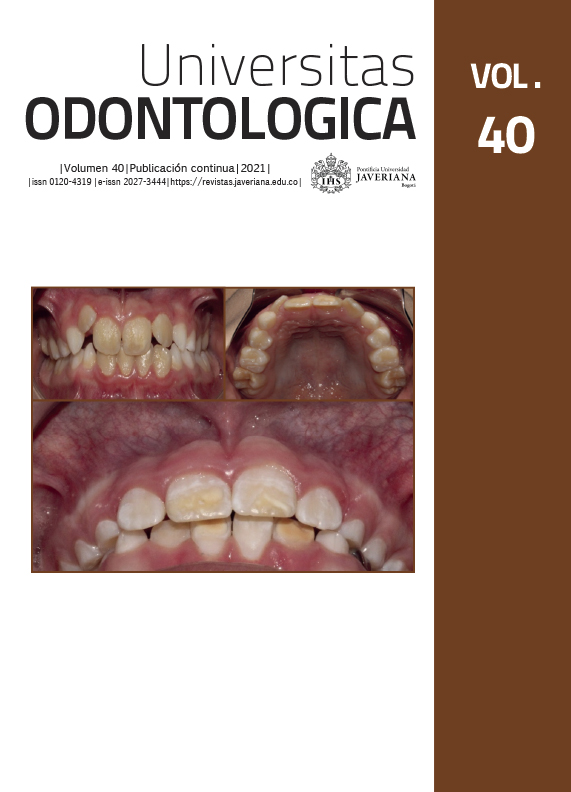Abstract
Background: Tooth whitening is a widely used aesthetic technique; however, some bleaching agents can affect enamel adhesive strength. There is interest in determining the effects of ozone and hydrogen peroxide, with and without calcium, on this property. Purpose: To evaluate the differences in enamel adhesive strength in bovine teeth subjected to tooth whitening with ozone, hydrogen peroxide with calcium, and hydrogen peroxide without calcium. Methods: An experimental study with an in vitro design was used. 75 bovine lower anterior incisors were divided into three groups (n=25 per group). The respective bleaching treatments were applied, and adhesive strength was measured using a digital universal testing machine at a speed of 0.5 mm/min. Measurements were taken at 24 hours, 7, 14, and 21 days after treatment. Data were analyzed using ANOVA and Tukey's post hoc test. Results: Statistically significant differences were observed between groups at 24 hours (p = 0.0044) and 7 days (p = 0.0026). The highest adhesive strength was recorded with 35% hydrogen peroxide with calcium at 21 days (11.50 ± 2.27 MPa). In all three groups, strength progressively increased over time. Conclusion: The type of bleaching agent and the time elapsed after treatment influence the adhesive strength of the enamel. Hydrogen peroxide with calcium showed the best performance at 21 days.
1. Santos HS, Ribeiro MES, Da-Silva TSP, Lima RR, Loretto SC, Honorato J. Evaluación de la masa de esmalte dental expuesto a protocolo de blanqueamiento dental supervisado prolongado con gel conteniendo calcio. Int J Odontostomatol. 2021; 15(2): 415-420. https://doi.org/10.4067/S0718-381X2021000200415
2. Vargas T, Ledezma T, Wu-WuSh W, Herrera OA. Efecto de blanqueamientos de oficina sobre el fosfato en el esmalte dental. Rev Odontol Mex. 2018; 22(1): 25-29. https://www.scielo.org.mx/scielo.php?pid=S1870-199X2018000100025&script=sci_arttext
3. Camargo MG, Natera A, Rodriguez M, Pimentel E, Tortolero MB. Blanqueamiento dental en niños y adolescentes ¿El epílogo de un mito? Revisión de la Literatura. Rev Odontopediatr Latinoam. 2021; 11(2): Article 2. https://doi.org/10.47990/alop.v11i2.261
4. Cessa ES. Aclaramiento dental: Revisión de la literatura y presentación de un caso clínico. Rev Asoc Dental Mex. 2018; 75(1): 9-25. https://www.medigraphic.com/pdfs/COMPLETOS/adm/2018/od181.pdf#page=13
5. Moradas M. ¿Qué material y técnica seleccionamos a la hora de realizar un blanqueamiento dental y por qué?: Protocolo para evitar hipersensibilidad dental posterior. Av Odontoestomatol. 2017; 33(3): 103-112. https://scielo.isciii.es/pdf/odonto/v33n3/original1.pdf
6. Magne P. Immediate dentin sealing: A fundamental procedure for indirect bonded restorations. J Esthet Restor Dent. 2005; 17(3): 144-154; discussion 155. https://doi.org/10.1111/j.1708-8240.2005.tb00103.x
7. Van der Vyver PJ, Lewis SB, Marais JT. The effect of bleaching agent on composite/enamel bonding. J Dent Assoc S Africa. 1997; 52(10): 601-603. https://pubmed.ncbi.nlm.nih.gov/9461903/
8. Santos GC, Baia JC, Ribeiro ME, Lima RR, E Sousa J, Loretto SC. Influence of prolonged bleaching with 4% hydrogen peroxide containing calcium and different storage times on the bond strength to enamel. J Contemp Dent Pract. 2019; 20(2): 216-220. https://europepmc.org/article/med/31058638
9. Marski SR, Ramos da Silva TF, Andrade ML, de Lima CO, Simão RA, Prado M. Effects of two in-office bleaching agents with different compositions on the bond strength to enamel. Int J Periodontics Restorative Dent. 2022; 42(5): 675-681. https://doi.org/10.11607/prd.5943
10. Yanık D, Er K, Kuştarci A. Shear bond strength of resin-modified glass ionomer cement bound to mineral trioxide aggregate after various disinfection protocols. Aust Endod J. 2023; 49(1): 159-164. https://doi.org/10.1111/aej.12641
11. Çelik N, Yapar MI, Karalar B, Kılıç M. Influence of laser and ozone pretreatment on the shear bond strength of fissure sealants: an in vitro comparative study. J Adv Oral Res. 2020; 11(2): 189-195. https://doi.org/10.1177/2320206820944285
12. Dinc G, Mujdeci A. Effect of ozone on bond strength of different restorative materials to enamel and dentin. Ozone Sci Eng. 2023; 45(1), 89-101. https://doi.org/10.1080/01919512.2022.2115976
13. Alaghehmand H, Rohaninasab M, Bijani A. The effect of office bleaching on the color and bond strength of resin restorations. Dent Res J. 2019; 16(1): 47-52. https://www.ncbi.nlm.nih.gov/pmc/articles/PMC6340226/
14. Cheng Y, Musonda J, Cheng H, Attin T, Zheng M, Yu H. Effect of surface removal following bleaching on the bond strength of enamel. BMC Oral Health. 2019; 19: 50. https://doi.org/10.1186/s12903-019-0742-4
15. Baia JCP, Oliveira RP, Ribeiro MES, Lima RR, Loretto SC, E Sousa J. Influence of prolonged dental bleaching on the adhesive bond strength to enamel surfaces. Int J Dent. 2020; (ID 2609359): 1-9. https://doi.org/10.1155/2020/2609359

This work is licensed under a Creative Commons Attribution 4.0 International License.
Copyright (c) 2025 Juan Enrique Bazán Ponce de León, María Angélica Fry Oropeza



